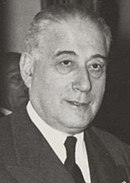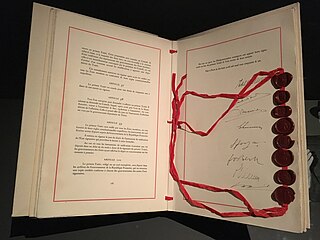
The High Authority was the executive branch of the former European Coal and Steel Community (ECSC). It was created in 1951 and disbanded in 1967 when it was merged into the European Commission.

The High Authority was the executive branch of the former European Coal and Steel Community (ECSC). It was created in 1951 and disbanded in 1967 when it was merged into the European Commission.
| History of the European Union |
|---|
 |
The High Authority was at the core of the idea of the ECSC. It was to be an independent, supranational executive checked by a Common Assembly. [1] There were concerns about this power, leading to a Council (of governments) and Parliament (of MPs) to be created to act as a counterweight. [2] [3] The inaugural sitting of the Authority was held in Luxembourg's city hall on 10 August 1952. Jean Monnet, the architect of the ECSC, was elected as its first President. [4]
The supranational power exercised by the Authority did prompt suspicion by some, for example the government of France who ensured that in the European Economic Community (EEC) and European Atomic Energy Community (Euratom) more power would be in the hands of the council. [3] [5] [6]
The Merger Treaty came into force in 1967; this combined the independent institutions of the ECSC and Euratom with those of the EEC. From that time the High Authority ceased to exist, its duties being taken on by the Commission of the European Communities. The administration of Rinaldo Del Bo ended before the merger so an interim President was appointed to oversee the merger, Albert Coppé. [7] The Authority met for the last time on 28 June 1967. [8]
The Authority's principal innovation was its supranational character. It had a broad area of competence to ensure the objectives of the treaty were met and that the common market functioned smoothly. The High Authority could issue three types of legal instruments: Decisions, which were entirely binding laws; Recommendations, which had binding aims but with methods left to member states; and Opinions, which had no legal force. [9]
The body consisted of nine members, nearly all appointed from the member states. The larger states, France, Germany and Italy, appointed two members each with the three smaller states, Belgium, Luxembourg and the Netherlands appointing one member each. The ninth member was the President, who was appointed by the eight other members. [9]
Despite being appointed by national governments, the members were not supposed to represent their national interest, but rather took an oath to defend the general interests of the Community as a whole. Their independence was aided by members being barred from having any occupation outside the Authority or having any business interests. [9]
The President was elected by the other appointed members, rather than directly by member states (as is the case of the current Commission President). The first president was Jean Monnet.
| N. | Portrait | President (Born–Died) | State | Took office | Left office | Authority | Party | Group | Electoral mandate | Refs | |
|---|---|---|---|---|---|---|---|---|---|---|---|
| 1 |  | Jean Monnet (1888–1979) | 10 August 1952 | 3 June 1955 | Monnet | Independent | None | – | |||
| 2 years, 297 days | |||||||||||
| 2 |  | René Mayer (1897–1965) | 3 June 1955 | 13 January 1958 | Mayer | PR | None | – | |||
| 2 years, 224 days | |||||||||||
| 3 |  | Paul Finet (1897–1995) | 13 January 1958 | 15 September 1959 | Finet | Independent | None | – | |||
| 1 year, 246 days | |||||||||||
| 4 |  | Piero Malvestiti (1899–1964) | 15 September 1959 | 22 October 1963 | Malvestiti | DC | None | – | |||
| 4 years, 51 days | |||||||||||
| 5 |  | Rinaldo Del Bo (1916–1991) | 22 October 1963 | 1 March 1967 | Del Bo | DC | None | – | |||
| 3 years, 130 days | |||||||||||
| 6 |  | Albert Coppé (1911–1999) | 1 March 1967 | 5 July 1967 | Coppé | CD&V | None | – | |||
| 126 days | |||||||||||

The headquarters of the High Authority were in Luxembourg city, the seat of most ECSC institutions. This was only intended as the provisional seat as no formal agreement was reached at the ECSC's conference in 1952. [10]
Luxembourg had proposed it be the provisional seat (except for the Common Assembly which was to be in Strasbourg) until an agreement was reached. [11] Future executives, the Commissions of the EEC and Euratom, would eventually be based in Brussels. [10]
The High Authority first had its offices in hotels, initially the Hôtel des Forges in Chateau de Beggen and then the Hôtel Grand-Chef in Mondorf-les-Bains. In 1953 it moved to the former seat of Luxembourg Railways on Place de Metz in Luxembourg, a grand building that later hosted the European Investment Bank from 1968 to 1980 and, since 1987, headquarters offices of the Banque et Caisse d'Épargne de l'État. [12]

The European Coal and Steel Community (ECSC) was a European organization created after World War II to integrate Europe's coal and steel industries into a single common market based on the principle of supranationalism. It was formally established in 1951 by the Treaty of Paris, signed by Belgium, France, Italy, Luxembourg, the Netherlands, and West Germany. The organization's subsequent enlargement of both members and duties ultimately led to the creation of the European Union.

The European Economic Community (EEC) was a regional organisation created by the Treaty of Rome of 1957, aiming to foster economic integration among its member states. It was subsequently renamed the European Community (EC) upon becoming integrated into the first pillar of the newly formed European Union in 1993. In the popular language, however, the singular European Community was sometimes inaccurately used in the wider sense of the plural European Communities, in spite of the latter designation covering all the three constituent entities of the first pillar.

The European Commission (EC) is part of the executive of the European Union (EU), together with the European Council. It operates as a cabinet government, with 27 members of the Commission headed by a President. It includes an administrative body of about 32,000 European civil servants. The Commission is divided into departments known as Directorates-General (DGs) that can be likened to departments or ministries each headed by a Director-General who is responsible to a Commissioner.

The Treaty of Rome, or EEC Treaty, brought about the creation of the European Economic Community (EEC), the best known of the European Communities (EC). The treaty was signed on 25 March 1957 by Belgium, France, Italy, Luxembourg, the Netherlands and West Germany, and it came into force on 1 January 1958. Originally the "Treaty establishing the European Economic Community", and now continuing under the name "Treaty on the Functioning of the European Union", it remains one of the two most important treaties in what is now the European Union (EU).

The Treaty of Paris was signed on 18 April 1951 between France, Italy, West Germany, Belgium, Luxembourg, and the Netherlands, establishing the European Coal and Steel Community (ECSC), which subsequently became part of the European Union. The treaty came into force on 23 July 1952 and expired on 23 July 2002, exactly fifty years after it came into effect.

The European Atomic Energy Community is an international organisation established by the Euratom Treaty on 25 March 1957 with the original purpose of creating a specialist market for nuclear power in Europe, by developing nuclear energy and distributing it to its member states while selling the surplus to non-member states. However, over the years its scope has been considerably increased to cover a large variety of areas associated with nuclear power and ionising radiation as diverse as safeguarding of nuclear materials, radiation protection and construction of the International Fusion Reactor ITER.

The European Communities (EC) were three international organizations that were governed by the same set of institutions. These were the European Coal and Steel Community (ECSC), the European Atomic Energy Community, and the European Economic Community (EEC); the last of which was renamed the European Community (EC) in 1993 by the Maastricht Treaty establishing the European Union. The European Union was established at that time more as a concept rather than an entity, while the Communities remained the actual subjects of international law impersonating the rather abstract Union, becoming at the same time its first pillar. In the popular language, however, the singular European Community was sometimes inaccurately used interchangeably with the plural phrase, in the sense of referring to all three entities. The European Coal and Steel Community ceased to exist in 2002 when its founding treaty expired. The European Community was merged with the second and third EU pillars by the Treaty of Lisbon in 2009, finally allowing the European Union to move beyond being only a concept and to assume the shape of a legally incorporated international organization with juridical personality, designated as the legal successor to the Community. However, the reformed EU has not become entirely unified, because Euratom, though governed with the EU by the common set of institutions, has been retained as an entity distinct from the EU, along with a number of other international entities, such as the European Investment Bank, the European University Institute, the European Stability Mechanism, and the Unified Patent Court.
The Merger Treaty, also known as the Treaty of Brussels, was a European treaty which unified the executive institutions of the European Coal and Steel Community (ECSC), European Atomic Energy Community (Euratom) and the European Economic Community (EEC). The treaty was signed in Brussels on 8 April 1965 and came into force on 1 July 1967. It set out that the Commission of the European Communities should replace the High Authority of the ECSC, the Commission of the EEC and the Commission of Euratom, and that the Council of the European Communities should replace the Special Council of Ministers of the ECSC, the Council of the EEC and the Council of Euratom. Although each Community remained legally independent, they shared common institutions and were together known as the European Communities. This treaty is regarded by some as the real beginning of the modern European Union.

The institutions of the European Union are the seven principal decision-making bodies of the European Union and the Euratom. They are, as listed in Article 13 of the Treaty on European Union:
The Euratom Treaty, officially the Treaty establishing the European Atomic Energy Community, established the European Atomic Energy Community. It was signed on 25 March 1957 at the same time as the Treaty establishing the European Economic Community.
The Legal Service of the European Commission is the in-house legal counsel to the commission, located in Brussels. It ensures that Commission decisions comply with EU law, preventing or reducing the risk of subsequent litigation. It provides legal advice to the commission and its departments, and represents the Commission in court cases.
The seven institutions of the European Union (EU) are seated in four different cities, which are Brussels (Belgium), Frankfurt am Main (Germany), Luxembourg (Luxembourg) and Strasbourg (France), rather than being concentrated in a single capital city. All four were chosen, among various reasons, for their location halfway between France and Germany, the countries whose rivalry led to two World Wars and whose reconciliation paved the way for European integration. The EU agencies and other bodies are located all across the union, but usually not fixed in the treaties. The Hague is the only exception, as the fixed seat of the Agency for Law Enforcement Cooperation (Europol). Over the years, Brussels has become the EU's political hub, with the College of the Commissioners – the European Commission's politically accountable executive – and the European Council both meeting at their Brussels-based headquarters, and the European Parliament and Council of the EU holding the majority of their meetings annually within the city. This has led to some referring to it as "the capital of the EU". However, Luxembourg City is the EU capital that can lay claim to having the most of the seven EU institutions based wholly or partly upon its territory, with only the European Council and European Central Bank not having a presence in the city.

The Monnet Authority was the first High Authority of the European Coal and Steel Community (ECSC), between 1952 and 1955. Its president was Jean Monnet of France.

The year 1948 marked the beginning of the institutionalised modern European integration. With the start of the Cold War, the Treaty of Brussels was signed in 1948 establishing the Western Union (WU) as the first organisation. In the same year, the International Authority for the Ruhr and the Organization for European Economic Co-operation, the predecessor of the OECD, were also founded, followed in 1949 by the Council of Europe, and in 1951 by the European Coal and Steel Community, with the ensuing moves to create further communities leading to the Treaty of Rome (1957)

The history of the European Communities between 1958 and 1972 saw the early development of the European Communities. The European Coal and Steel Community (ECSC) had just been joined by the European Atomic Energy Community (Euratom) and the European Economic Community (EEC), the latter of which soon became the most important. In 1967 the EEC's institutions took over the other two with the EEC's Commission holding its first terms under Hallstein and Rey.

This is a timeline of European Union history and its previous development.

The Messina Conference of 1955 was a meeting of the six member states of the European Coal and Steel Community (ECSC). The conference assessed the progress of the ECSC and, deciding that it was working well, proposed further European integration. This initiative led to the creation in 1957 of the European Economic Community and Euratom.

The Spaak Committee was an Intergovernmental Committee set up by the Foreign Ministers of the six Member States of the European Coal and Steel Community (ECSC) as a result of the Messina Conference of 1955. The Spaak Committee started its work on 9 July 1955 and ended on 20 April 1956, when the Heads of Delegation of the six Member States of the ECSC approved the Spaak report. The committee worked on two main topics, one was the creation of a general common market and the other one was the establishment of a European Community for the peaceful use of atomic energy.

The Benelux memorandum of 1955 was a document drafted by the three Benelux countries on 18 May 1955 as a means to reviving European integration on the basis of a general common market.

The European Schools is an intergovernmental organisation, which has established, finances, and administers a small group of multilingual international schools, bearing the title "European School", which exist primarily to offer an education to the children of European Union (EU) staff; offers accreditation to other schools, bearing the title "Accredited European School", under national jurisdiction within EU member states to provide its curriculum; and oversees the provision of the secondary school leaving diploma, the European Baccalaureate.